Pool, Spa, or Both? How to Decide What Option Is Best for Your Yard
April 25th, 2022
4 min read
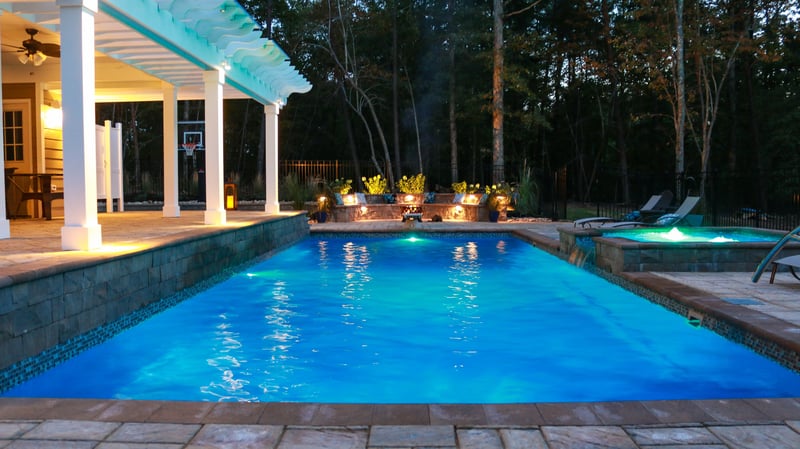
When you think about relaxing at home, what comes to mind? Is it sinking into a bubbling spa, or do you see yourself chilling poolside or on a nice tanning ledge? Maybe you see yourself having it all. Whatever your vision may be, there’s options out there for you to make it a reality.
Here at River Pools, our team loves to not only teach about the world of swimming pools, but also help homeowners like you make the decision that’s best for their families (even if that decision isn’t us). In this article, we’re going to go over why someone might choose a pool over a spa (or vice versa), some pool and spa designs available and what your options are if you want both.
Sound like a plan? Then let’s head in (hold your nose, or not)!
Benefits of a Pool vs a Spa
Pools and spas each have their own unique benefits, but they can also complement each other nicely. To help you decide between a pool or a spa, let’s give a couple pros and cons of owning each:
Pool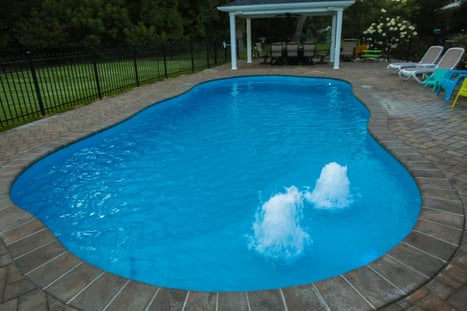
Pros:
- More swim room
- Allows for activities
- Help you cool off (but can also be heated)
Cons:
- Takes up more room (not as easy to accommodate for some yards)
- May have to close for a portion of the year depending on where you live
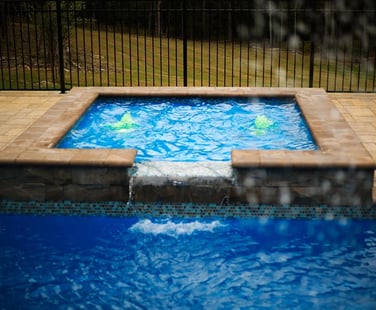 Spa
Spa
Pros:
- Cozy/warm
- Meant for relaxation/Therapeutic benefits
- Can often be used year-round in colder climates
- Able to fit in many different sized yards
Cons:
- More chemicals to maintain due to higher water temperatures
- Less room (built for relaxing, not swimming)
Some of the cons listed above may actually be pros depending on what you’re looking for, and vice versa. Pool designs you consider will depend on what you’re looking to get out of your pool. Do you plan on getting chairs to lounge? A pool with a tanning ledge would be right up your alley. Are you wanting to practice your diving skills? Pool designs that meet safety requirements for a diving board would be a must. With a spa, you will often see them square or round - both are lovely, so the decision comes down to what look you’re going for in your space.
Pool and Spa Options Available
Available pool and spa designs can be almost anything you can imagine - small pool designs, modern rectangular pool designs, square and round spas, etc. - depending on the type of pool you choose. Concrete and vinyl liner pools, for example, are built right in your backyard and can be customized to be all sorts of shapes and sizes (meaning, the pool is yours to command).
However, fiberglass is different. Fiberglass pools and spas are manufactured in facility settings and are crafted from molds. The designs of these molds are determined by the manufacturer, so your choices will be limited to what the manufacturer has to offer. But fear not! Fiberglass pools have come a long way over the years and now offer many desired pool features, like tanning ledges/sun shelves, deep-end benches, dedicated swim lanes and more.
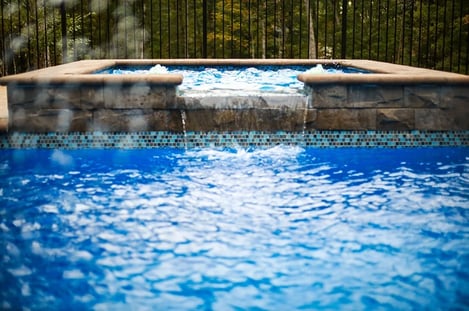
When it comes to spas, you have a couple add-ons at your disposal. One example is a spillover spa. How does a spillover spa work, you might ask? Well, a spillover spa is basically a spa that is constructed to have a pouring, or “waterfall”, effect going into your pool. Pumps are used to move the water up and over the spa’s edge. This tends to be used in spas that are separate from the pool. The spillover option is an aesthetic choice that can add a real sense of elegance to your pool/spa setup. However, it’s important to note that with this setup requires pulling water from your pool to overflow the spa, thus creating the spillover effect. Because of this, you lose efficiency with your heater.
In a typical spa, the water is pulled from the spa, passed through the heater and returned to the spa. Spas heat up quickly compared to pools since there is less water to heat. In a spillover spa, the water is pulled from the pool - a significantly larger and cooler body of water - via pumps. Because the pumps are pulling water from the pool to create the spillover spa’s overflow, the water starts at the pool’s temperature and the heater’s relative increase gives you water way colder than a recirculating system pulling water from an already warmed spa. A smaller amount of water in a regular spa makes a more efficient heating process as opposed to the spillover, which is heating pool-temperature-water constantly.
Essentially, in a spillover, heat is coming from the pool rather than heating and circulating directly within the spa. The direct flow from heater to spa and back to heater is much more efficient than the heater-to-spa-to-pool and back to heater circulation since water has to do less traveling to heat up. Ultimately, if you want a hot spa without heating the pool you need either a main drain in the spa and valves to divert water away from the pool to the spa, or a separate dedicated set of equipment for the spa (recommended). We’ve created a handy infographic to demonstrate what we’re talking about when it comes to heating a spillover spa vs a regular spa:
You can also add extra jets for that maximum resort feel. (Fun fact: jets can be added to your inground fiberglass pool, too!)

What is a Pool/Spa Combo & Is It A Good Fit For You?
It’s time we answer those questions we’re sure are swirling around in your head: what is a pool and spa combo called? And how do pool spa combos work? These dynamic duos are in fact called pool and spa combos, and they are pools that come with a spa/hot tub already built in. In the case of fiberglass pools, the pool is designed with the spa inside of it, so the mold has both the pool and spa included in it. With the spa and pool being together as one, they are connected to the same filtration system which can mean easier maintenance than if your pool and spa were separate. However, your maintenance costs will be greater than if you just owned a pool (whether the spa is attached or separate) since you’ll need more chemicals to maintain it and more electricity to heat it up.
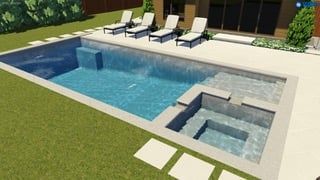
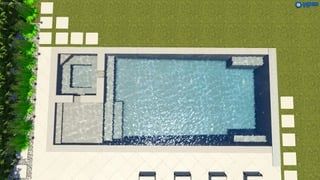
Is it worth putting a spa in a pool? This is absolutely your call to make, and may or may not make sense with what you’re looking for in a pool design and management setup. If your yard doesn’t have the space for a separate pool and spa, if you like the idea of flowing access between your pool and spa without exiting the water, and/or you like the luxury feel these designs give, a pool and spa combo might be the way to go. Plus, when you do need to cover up your pool, having the combo allows you to use one cover instead of two - definitely a bonus.
Conclusion
That’s the story, friends. Or at least the gist of it. So, is it worth putting a pool in your backyard (or a spa)? We hope this article aided you in making that choice.
At River Pools, we manufacture and install one-piece inground fiberglass pools for folks across the country. If you’d like to get more details on either pools and/or spas of the fiberglass variety, you can talk to a River Pools dealer in your area (click the button below). Want to learn more about how we build and install our pools? Click here and here. If you’d like to get an idea of a fiberglass pool’s cost, you can try out our pool cost calculator.

